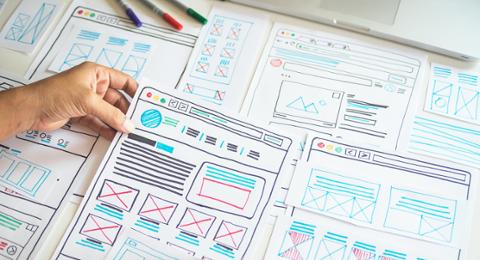The UX profession has grown substantially since Don Norman coined the term “user experience” in 1993, and it remains a rapidly evolving discipline with shifting roles and multiple career paths. A UX designer's role and responsibilities can vary dramatically from one company to another—and sometimes even from project to project.
So whether you’re thinking about becoming a UX designer or have been at it for a few years, you may be wondering how you can progress to a higher level or a different career path. What are your options and how do you get there?
Here’s a look at the most viable career paths that allow you to use the knowledge and experience you’ve acquired as a UX designer.
Generalist to Specialist
If you start out as a generalist and find your curiosity and talents leading you down a UX rabbit hole, consider specializing in one or two areas of UX design, explained Rachel Krause, senior UX specialist and co-author of research report “What a UX Career Looks Like Today.”
“Management isn’t the only way to grow,” Krause pointed out.
For instance, if you’re fascinated by user behavior, you can become a subject matter expert by focusing on research activities—or make the outright switch to UX researcher. Or perhaps you’d like to specialize in running UX workshops, creating UX strategies or various aspects of UX design such as conversation design, interaction design or motion design.
Alternatively, if the idea of working at the intersection of UX and information architecture appeals to you, consider becoming a UX architect.
While the UX profession is here to stay, the roles of individual contributors are fragmenting to meet the changing needs of users, noted Nick Finck, user experience coach, advisor, mentor and founder of Craft & Rigor.
As a result, it’s getting harder for generalists to stand out, noted UX career expert and coach Sami Gardner. Therefore, it’s going to be more important for designers to have a specialty or focused discipline going forward.
If you’re working as a generalist, Gardner pointed out that you can still develop a specialized skillset and build your portfolio by taking online courses, completing side projects or transitioning to different UX teams within your own company.
Generalist to Vertical Specialist
Another way to achieve career growth is through vertical specialization by designing for a particular industry or product type. For instance, moving to an embedded role in marketing can allow you to focus on how users will engage and interact while using your product. Other emerging vertical specialties include library UX, automotive UX and sports UX.
Need more ideas? According to the research report, some of the top sectors for UX design include computers and IT, finance, education, government, healthcare and social services, retail, media and publishing, telecommunication, business, entertainment, aerospace and nonprofit.
Advanced UX Roles
Individual contributors can also become senior, lead or principal UX designers. Senior professionals still perform the duties of a UX designer but are also responsible for leading a small team and/or the UX design process.
While lead designers don’t typically have direct reports, expanding your responsibilities, scope and leadership skills might lead you into a management or UX project management position.
UX Developer or Engineer
If you’ve made a career switch from front-end web development to UX design, or even just learned how to code, you could move into a hybrid role as a UX developer.
Today, more and more companies are seeking their own designer-developer pros. For instance, in the last five years, IBM has increased its designer to developer hiring target from 1:72 to 1:8.
You can also combine your knowledge of programming languages and development with UX design to become a UX engineer. Other niche areas that represent the next frontiers in UX design (and where coding knowledge is definitely a plus) include virtual reality UX, augmented reality UX, mixed reality UX and voice user interface design.
UX Related Roles
Your UX experience can also serve as a bridge to other tangential careers that require a solid grasp of UX fundamentals and user-centered design, such as product designer, product manager or information architect.
UX Management
While management isn’t the only upward path for UX professionals, it’s certainly an option for those who want to be responsible for hiring, managing and developing people and creating a cohesive, high performance UX team and culture.
Creative directors and UX managers are also tasked with delegating tasks, establishing deadlines and prioritizing work, budgeting, approving designs and consulting with stakeholders, developers, software engineers and the marketing department.
Working as a UX team lead and assisting your manager with projects and tasks can help you develop the managerial and communication skills to succeed at the next level. Gardner suggests that you check out Tech Fleet, an education and coaching community that provides apprenticeships and learning experiences for aspiring UX researchers, UX designers, product managers, project managers and developers through real-world project work.
Related UX Designer Jobs Resources:



